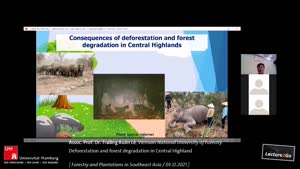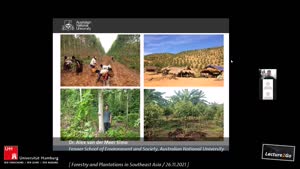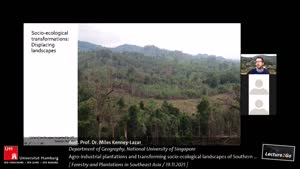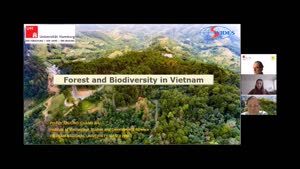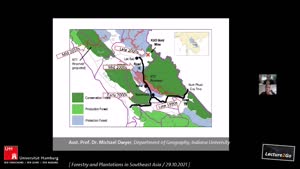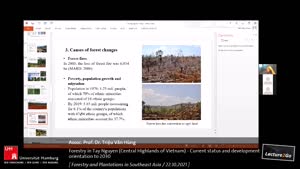Forestry in Tay Nguyen (Central Highlands of Vietnam) - Current status and development orientation to 2030 - Assoc. Prof. Dr. Hùng Văn Triệu - Universität Hamburg
- Lecture2Go
- Videokatalog
- F.5 - Geisteswissenschaften
- Asien-Afrika-Institut
- Forestry and Plantations in Southeast Asia
Videokatalog
2694 Aufrufe
22.10.2021
Forestry in Tay Nguyen (Central Highlands of Vietnam) - Current status and development orientation to 2030
Tay Nguyen (TN) or Central Highlands is a highland region in Central Vietnam, consisting of 5 provinces, bordered to the north and east by the coastal provinces of Vietnam, to the west by Laos and Cambodia. These are the successive plateaus from an altitude of 500m to about 1500m above sea level. TN has a tropical climate and suitable soil conditions for plant growth, so forest resources are very rich and diverse in ecosystem types such as evergreen broadleaf forest, mixed closed needle-broadleaf forest, coniferous forest, bamboo forest, semi-deciduous closed forest, deciduous forest etc. It is one of the regions with very high biodiversity of Vietnam with many endemic species, such as Thuy tung (Glyptostrobus pensilis), Da lat pine (Pinus dalatensis), ... Wild fauna is also very rich with more than 30 rare species such as elephants, gaurs, wild buffaloes, tigers, bears, etc. Apart from the value of forest products and conservation of biodiversity, TN’ forests also have an important role in protecting the environment, especially water resources because this is the watershed of several rivers, known as the "roof of Indochina".
In recent decades, forest resources in TN have been seriously degraded. In 2005, the total forest area was 2.97 million ha, accounting for 23.53% of Vietnam's forest area. By 2020, it is only 2.56 million ha, equal to 17.44% of the national forest area. In last 15 years, the forest cover rate in TN decreased from 54.4% to 45.9%. The area of natural forest was reduced from 2.83 million ha to 2.18 million ha, losing 0.65 million ha. In 2005, the TN' natural forest accounted for 27.5% of the country's natural forest area; in 2020 this is only 21.2%. In 2005, the timber stock of TN’ forests accounted for 33.55% of the timber stock of the forest in whole country, and in 2020 this number is only 27%. Forest degradation has led to serious economic, social and environmental consequences, such as soil degradation and increasing drought, for example, in 2003 the drought reduced coffee yield by 25%, in 2016 the drought occurred on 70% of the cultivated area, with an estimated loss of 60 million USD.
The causes of deforestation and forest degradation are: i) Unsustainable logging and illegal logging; ii) converting forests to agricultural production, typically planting industrial crops such as coffee, rubber, cashew, pepper, fruit trees, etc.; iii) construction of transport infrastructure, hydropower, ...; iv) forest fires; v) poverty, population growth and migration; vi) limited forest management capacity of the State, especially at grassroots level; and vii) lack of funds for forest protection and development.
In order to restore forests and develop sustainable forestry in Vietnam in general and TN in particular, the Government of Vietnam has implemented many policies such as banning exploitation of natural forests since 2017, promote protection of existing forests and afforestation, implement sustainable forest management and forest certifications according to national and international standards. In the period of 2021 - 2030, the main tasks for forestry in TN should be: strictly protect the existing natural forests; stop illegal forest exploitation; restrict the conversion of forests to other purposes; forest restoration and afforestation to reach a total forest area of 2.69 million ha by 2030, equivalent to a forest coverage rate of 49.2%, of which about 40% are special-use forests and protection forests, 60% are production forests. Focus priority in strengthening and development of watershed protection forests and special-use forests such as national parks, nature reserves, and specific ecosystems such as pine forests, dipterocarp forests etc.; to step up the planting of production forests and agro-forestry in association with the forest product processing industry.
Solutions to develop forestry in TN is continue to improve forest policy to meet the requirements of sustainable development, to attract investment in forestry, to develop forestry in association with improving the livelihoods of local people; strengthen propaganda to raise awareness about the values of forests for biodiversity conservation and forest environmental services; strengthen cooperation in research, capacity building, forest product market development, and harmonization of national with international forestry regulations; implementing international agreements/ commitments related to forestry, such as VPA/FLEGT, EVFTA, NDC, CITES, UNCBD, UNCCD, NFCCC etc.
Triệu Văn Hùng is Associate Professor specialising on forestry and silviculture. After conducting his graduate studies at the TU Dresden, he has worked as a lecturer at the Vietnam Forestry University before working for the Vietnamese Ministry of Agriculture and Rural Development. He has worked in different projects, for example as a director for the UNDP-funded project “Strengthening the capacity of the village community to develop and implement a plan to limit deforestation and forest degradation in Ta Ngai Cho Commune, Muong Khuong District, Lao Cai Province, contributes to sustainable forest management and redness to REDD+ at the provincial level”. In 2020, he has served as a national consultant in developing Vietnam's forestry development strategy for the period 2021 to 2030 with vision to 2050. Next to that, he works as an independent cunsultant, serves as the editor-in-chief of the Vietnam Journal of Forest and Environment and is the chairman of the Vietnam Forestry Science and Technology Association (VIFA).
---
“Forestry and Plantations in Southeast Asia (SEA)” is the topic of a two-semester series of classes. During the summer semester of 2021, the class has already covered insular SEA, especially Indonesia and the Philippines. In the fall-winter semester of 2021/22, the focus will be on continental SEA. Especially the Central Indochinese Highlands will be in the center of attention, and on the side of the three countries Vietnam, Laos and Cambodia. In recent decades, it is well known that so much natural forest area has been lost, so many hectares of plantations have been developed, starting in Vietnam, then spreading across the borders to Lower Laos and Northeastern Cambodia. The Vietnamese logging and plantation company Hoàng Anh Gia Lai is one prominent example. Similar processes occur in Northern Indochina as well, for instance along the Laos-China border. During the seminar and lecture series, we would like to raise some of the following questions, for example: How did deforestation happen, and how did the plantation industry grow - causes, processes, and consequences. How would forestry or ecology sciences, geography or sociology assess this matter? What could and should be to done to preserve the natural tropical rain forest? Are there are positive, effective methods to avoid the complete loss of natural tropical forests in the region of SEA, or is it doomed to disappear? The seminar includes a number of guest lectures from experts of the field who will give insights into the topic from different perspectives.
---
“Forestry and Plantations in Southeast Asia (SEA)” is the topic of a two-semester series of classes. During the summer semester of 2021, the class has already covered insular SEA, especially Indonesia and the Philippines. In the fall-winter semester of 2021/22, the focus will be on continental SEA. Especially the Central Indochinese Highlands will be in the center of attention, and on the side of the three countries Vietnam, Laos and Cambodia. In recent decades, it is well known that so much natural forest area has been lost, so many hectares of plantations have been developed, starting in Vietnam, then spreading across the borders to Lower Laos and Northeastern Cambodia. The Vietnamese logging and plantation company Hoàng Anh Gia Lai is one prominent example. Similar processes occur in Northern Indochina as well, for instance along the Laos-China border. During the seminar and lecture series, we would like to raise some of the following questions, for example: How did deforestation happen, and how did the plantation industry grow - causes, processes, and consequences. How would forestry or ecology sciences, geography or sociology assess this matter? What could and should be to done to preserve the natural tropical rain forest? Are there are positive, effective methods to avoid the complete loss of natural tropical forests in the region of SEA, or is it doomed to disappear? The seminar includes a number of guest lectures from experts of the field who will give insights into the topic from different perspectives.
Technischer Support
Bitte klicken Sie auf den nachfolgenden Link und füllen Sie daraufhin die notwendigen Felder aus, um unser Support-Team zu kontaktieren!
Link zu der RRZ-Support-Seite

